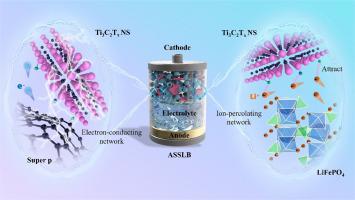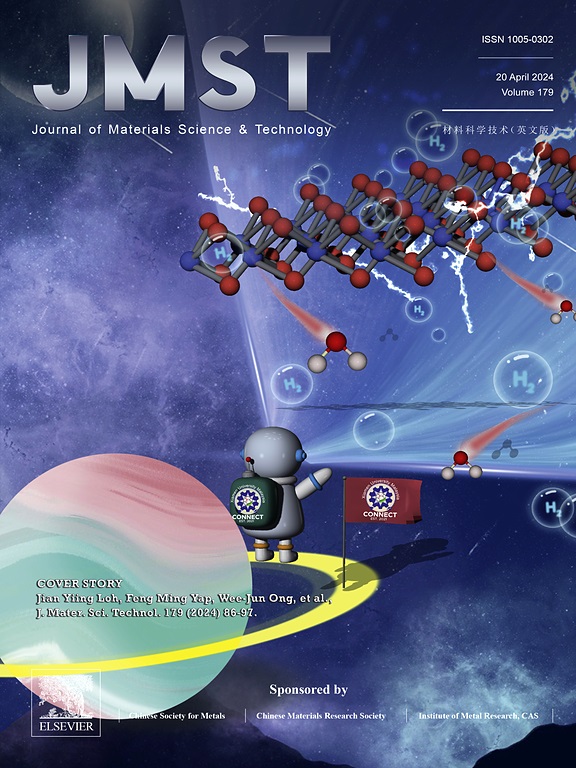Ti3C2Tx MXene enhanced high-performance LiFePO4 cathode for all-solid-state lithium battery
IF 11.2
1区 材料科学
Q1 MATERIALS SCIENCE, MULTIDISCIPLINARY
引用次数: 0
Abstract
All-solid-state lithium batteries (ASSLBs) are important for enhancing safety across various applications related to lithium-ion batteries (LIBs). Lithium iron phosphate (LiFePO4) is a widely utilized commercial cathode in LIBs, prized for its stable cycling performance, thermal stability, and low cost. However, low electronic conductivity and slow ion diffusion kinetics limit its application at high rates and low temperatures. Herein, Ti3C2Tx MXene nanosheets (NSs) are introduced into the LiFePO4 cathode. The continuous electron-conducting networks are constructed due to the high electrical conductivity of Ti3C2Tx NSs. Meanwhile, the coordination environment of lithium ions in the cathode is weakened by the oxygenated end groups of Ti3C2Tx NSs, and thus efficient ion-percolating networks are constructed. Therefore, the ionic and electronic conductivities of the modified cathode are significantly improved. Assembled all-solid-state LiFePO4/Li full cells with poly(ethylene oxide) as electrolyte exhibits high initial discharged capacities of 91.5 mAh g−1 at 10 C, and capacities of 155.1 mAh g−1 after 1000 cycles at 1 C with a retention rate of 93.8%. Furthermore, the cells still deliver excellent performance at high loading, room temperature, and low temperature. This work offers a facile and scalable strategy for designing high-performance ASSLBs.

用于全固态锂电池的 Ti3C2Tx MXene 增强型高性能磷酸铁锂正极
全固态锂电池(ASSLBs)对于提高与锂离子电池(lib)相关的各种应用的安全性非常重要。磷酸铁锂(LiFePO4)因其稳定的循环性能、热稳定性和低成本而被广泛应用于锂离子电池(LIBs)中。然而,低的电子导电性和缓慢的离子扩散动力学限制了它在高速率和低温下的应用。本文将Ti3C2Tx MXene纳米片(NSs)引入LiFePO4阴极。由于Ti3C2Tx NSs的高导电性,构建了连续的电子传导网络。同时,Ti3C2Tx NSs的端基氧化削弱了锂离子在阴极中的配位环境,从而构建了高效的离子渗透网络。因此,改性阴极的离子电导率和电子电导率都得到了显著提高。以聚环氧乙烷为电解液组装的全固态LiFePO4/Li全电池在10℃下的初始放电容量为91.5 mAh g−1,在1℃下循环1000次后的放电容量为155.1 mAh g−1,保留率为93.8%。此外,该电池在高负载、室温和低温下仍然具有优异的性能。这项工作为设计高性能assb提供了一种简单且可扩展的策略。
本文章由计算机程序翻译,如有差异,请以英文原文为准。
求助全文
约1分钟内获得全文
求助全文
来源期刊

Journal of Materials Science & Technology
工程技术-材料科学:综合
CiteScore
20.00
自引率
11.00%
发文量
995
审稿时长
13 days
期刊介绍:
Journal of Materials Science & Technology strives to promote global collaboration in the field of materials science and technology. It primarily publishes original research papers, invited review articles, letters, research notes, and summaries of scientific achievements. The journal covers a wide range of materials science and technology topics, including metallic materials, inorganic nonmetallic materials, and composite materials.
 求助内容:
求助内容: 应助结果提醒方式:
应助结果提醒方式:


